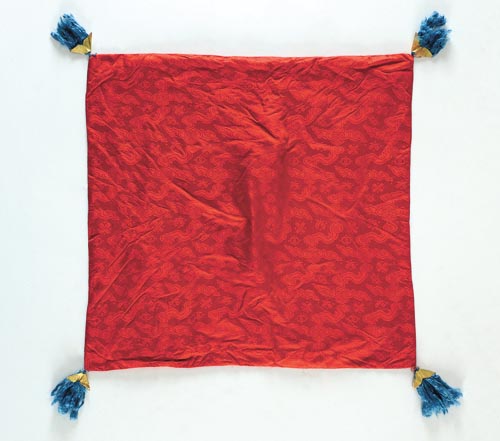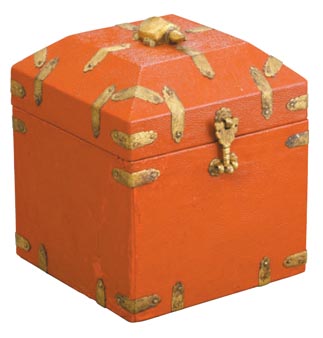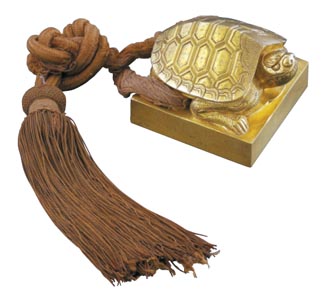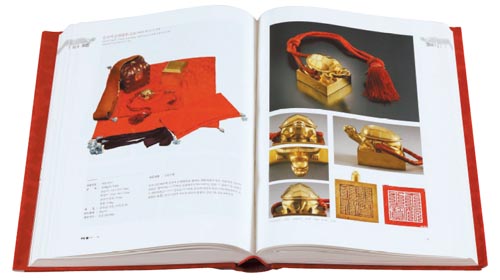Catalogue highlights the beauty of royal Korean seals

This cloth was used to cover a royal seal.
Korea’s Cultural Heritage Administration announced Tuesday that it has published a three-volume catalogue titled “The Royal Seals of Joseon.”
The royal seals, known in Korean as “eobo,” were largely ceremonial and primarily used for weddings and other rituals. They were different from state seals, which were used for official documents and national orders.
The catalogue presents the most information ever collected about the seals and features images of both the seals and their accompanying accessories. In all, the catalogue contains information on more than 3,300 artifacts.
The cultural administration hopes it will be an invaluable resource for scholars, the general public and anyone interested in Joseon Dynasty culture, as well as metal and woodcraft arts.

Royal seals were protected by an inner and outer box. This box has a small turtle on top, which is the same as the ornament that decorates the seal inside. Provided by the Cultural Heritage Administration of Korea
The catalogue documents 316 royal seals used by 34 Joseon kings, 48 queens and other royal family members.
The earliest seal was used in 1441 by Queen Hyeondeok, the wife of King Munjong (1414-1452), and the most recent one was used by in 1928 by Queen Sunmyeonghyo, the wife of King Sunjong (1874-1926).
Seals usually composed of two parts: the square base, or “boshin,” on the underside, where the letters are engraved, and the handle, or “bonyu,” an animal ornament. “Insu,” or decorations such as bells and tassels, were added for visual appeal and, at least when it came to the tassel, made it easier to hold the seal.
The seals were traditionally wrapped in silk cloth and placed in a box called a “botong.” The botong was then wrapped again and placed in an outer box called “borok.”

Royal seals had two parts - the base and an ornament in the shape of a turtle or other animal. The seal was also decorated with a tassel, which not only enhanced its visual appeal but also made it easier to hold.
The fabric used to cover the boxes was adorned with auspicious symbols such as clouds, money and books. Colors and prints woven into the fabric are now used to study the development of sewing and dying during the Joseon era.
When the Korean Empire (1897-1910) succeeded the Joseon Dynasty (1392-1897), the animal ornament on top of the seal changed from a turtle to a dragon, which was the symbol of the new emperor.

One volume from a new three-volume catalogue on royal seals published by the Cultural Heritage Administration of Korea shows the seals and their decorations.
The first volume of the catalogue introduces different kinds of eobo and the second one shows the inner and outer boxes and the keys and locks used to secure them. The third book focuses on the fabrics used to wrap the eobo and other ornaments associated with the seals.
The Cultural Heritage Administration is hoping to register the collection of seals as objects of World Cultural Heritage with the United Nations Educational, Scientific and Cultural Organization, according to a press release from the CHA on Tuesday.
The catalogue will be available to the public at national and public libraries this month.
By Lee Sun-min [summerlee@joongang.co.kr]
Related Korean Article [중앙일보]
거북에서 용으로 바뀐 조선 왕실의 어보
국립고궁박물관 『 … 어보』 3권 발간
문화재·세계문화유산 등재도 추진
태조 이성계의 4대 조상부터 27대 순종에 이르는 조선 왕실 어보(御寶)를 집대성한 자료가 나왔다. 국립고궁박물관(관장 정종수)은 소장 어보 316점을 포함한 관련 유물 3361점에 대한 소개와 연구논문을 담은 자료집 『조선왕실의 어보』(전 3권)를 발간했다.
어보는 존호(尊號)·시호(諡號)를 올리거나 가례(嘉禮)·길례(吉禮) 등의 궁중 의식을 열 때 사용한 왕실 권위의 상징물이다. 이들 어보 관련 유물은 종묘에 보관돼 있다 국립고궁박물관으로 이관된 유물이다. 국립중앙박물관을 비롯한 국내외 기관과 개인이 더러 소장한 예가 있으나 절대 다수가 고궁박물관에 소장돼 있다. 어보는 거북이나 용으로 장식한 의례용 도장, 그것을 담는 내함(內函)인 보통(寶筒), 외함(外函)인 보록(寶盝), 그리고 어보·보통과 보록을 싸는 보자기와 이를 묶는 끈 등 최소 6개 이상의 부품이 한 묶음을 이룬다. 조선시대 유교문화의 특성을 살필 수 있다. …
http://news.joins.com/article/917/4913917.html?ctg=










with the Korea JoongAng Daily
To write comments, please log in to one of the accounts.
Standards Board Policy (0/250자)